Part 3: Forecast statement of service performance for each of the three years 2011/12, 2012/13, and 2013/14
Output class: Audit and assurance services
The main purpose of an annual audit is to provide independent assurance about the fair disclosure of the financial – and, in many instances, non-financial – information within annual reports. An audit involves a range of procedures, tests, and management and governance enquiries to support our audit opinion.
In carrying out annual audits, auditors consider the legislative audit mandate. They may also recommend improvements in matters of effectiveness and efficiency, waste, probity, and financial prudence in management letters to the governors and managers of public entities. We also use our annual audits to gather information and knowledge about public entities to assist us in advising Parliament and other stakeholders, and to help determine the work we do in our performance audits, inquiries, and good practice guides.
In 2009/10, annual audits and other assurance services accounted for 87% of our total expenditure. Most of the output class relates to annual audits for public entities. The annual audits are required by statute.
Types of annual audit reporting
The audit report is one of the reports from the annual audit process and is addressed to the readers of the financial statements and (where applicable) the statement of service performance. It provides the auditor’s independent opinion (the audit opinion) on whether the financial statements (and, where applicable, the performance information) fairly reflect the public entity’s performance and financial position. If the financial statements fairly reflect the public entity’s financial performance and position (and, where applicable, performance information), the auditor issues an audit report with an unqualified opinion. However, if the auditor identifies a material error or omission in the financial statements or performance information, the auditor issues an audit report with a qualified opinion.
The management report is addressed to the governing body or the senior management of public entities. It sets out any significant issues identified by the auditor during the audit and provides recommendations for improving the public entity’s controls, systems, and processes.
If the public entity is subject to financial review by select committees, we report the results of its annual audit to responsible Ministers and select committees. The financial review report includes a grading for public entities, based on our assessment of their management control environment and financial and service performance (where required), systems, and controls.
Our focus
In the next year, within our annual audit and assurance work, we will be focusing on:
- Implementing Ministry of Economic Development and External Reporting Board changes – We will continue to focus on making a positive contribution to the work of the Ministry of Economic Development and the External Reporting Board in setting and implementing accounting and auditing standards. We will also consider the implications of auditor regulation, which is being introduced under changes to the Financial Reporting Act 1993 (the Act). In the public sector, auditor regulation relates only to issuers, which are legal entities that develop, register, and sell securities for the purpose of financing their operations. A number of public entities are issuers under the Act.
- Performance information – We are phasing in the Auditor-General’s revised auditing standard on reporting performance information during the three financial years ending 30 June 2011 to 30 June 2013. With the Treasury, we are working directly with public entities during the three years to enable auditors to apply the revised auditing standard to audits of performance information for the year ending 30 June 2013.
- Sharing sector knowledge – We will continue with our initiative to share knowledge within the organisation. The initiative consolidates and expands on our previous work to help us better understand and use our knowledge about individual public entities, various sectors, and the public sector as a whole. We expect the initiative to extend our ability to be flexible, agile, and adaptive.
The Vote estimate for the Audit and assurance services output class in 2011/12 is $71.601 million.
Our impacts and outputs for Audit and assurance services are summarised in Figure 7. Details of our measures and standards for this output class, and our previous performance, are shown in Figure 8.

Figure 7
Summary of impacts and outputs for Audit and assurance services
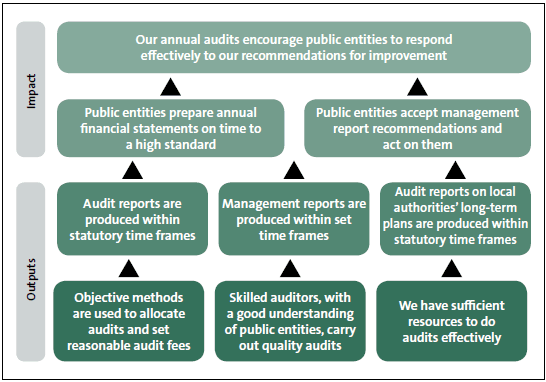
Figure 8
Impact and output measures and standards, and previous performance, for Audit and assurance services
| Measures and standards | Previous performance |
|---|---|
| Our annual audits encourage public entities to respond effectively to our recommendations for improvement Central government entities’ management control environment, financial information, and service performance information systems and controls are improved (or at least maintained), measured against the previous two years. |
8.1 Grades for management control environment for 2007, 2008, and 2009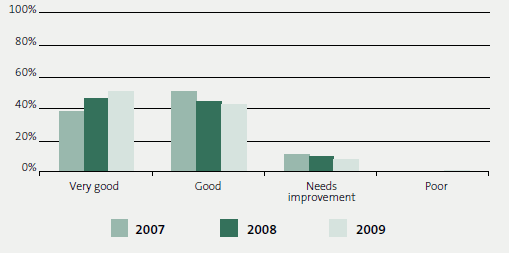 |
8.2 Grades for financial information systems and controls for 2007, 2008, and 2009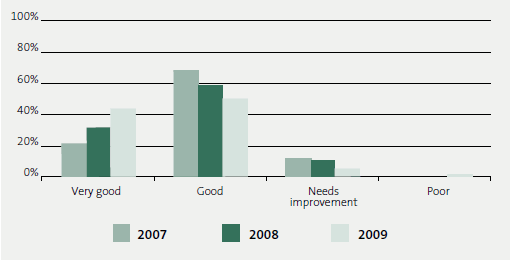 |
|
8.3 Grades for service performance information and associated systems and controls (SPIASC) for 2008 and 2009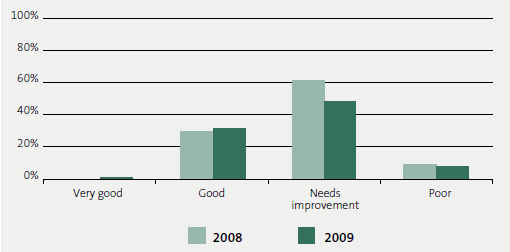 SPIASC was first graded in 2008/09. The 2008/09 results did not include district health boards (DHBs), which were all graded "needs improvement/poor", but the 2009/10 results did include DHBs that were graded either "needs improvement" or “poor”. |
|
| Public entities prepare annual financial statements on time to a high standard The percentage of public entities’ audited financial reports containing qualified opinions is reduced (or at least maintained), measured against the previous two years. |
8.4 Percentage of audited financial reports that contain qualified audit opinions for the five years from 2006 to 2010 |
| Public entities accept management report recommendations and act on them Public entities’ acceptance of audit service providers’ management report recommendations is improved (or at least maintained), measured against the previous two years. (Note – In previous years, this has been assessed against only Audit New Zealand’s management report recommendations.) |
8.5 Percentage of management report recommendations accepted by public entities for the five years from 2006 to 2010 |
| Audit reports are produced within statutory time frames The percentage of public entities’ audited financial reports issued within the statutory time frame is improved (or at least maintained), measured against the previous two years. |
8.6 Percentage of audits completed on time for the five years from 2006 to 2010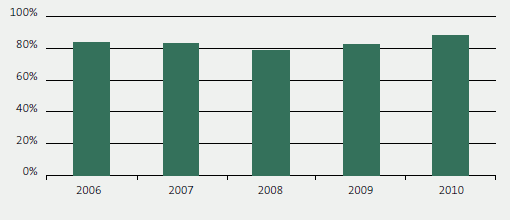 |
| Audit reports are produced within statutory time frames Less than 30% of the outstanding audit reports at 30 June 2010 are because of inaction on our part. |
8.7 Percentage of outstanding audit reports at 30 June because of our inaction for the four years from 2007 to 2010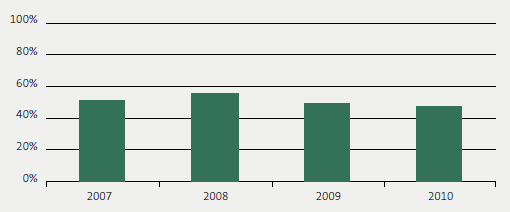 |
| Management reports are produced within set time frames All management reports are issued within six weeks of issuing the audit report. |
8.8 Percentage of management reports issued within six weeks for the five years from 2006 to 2010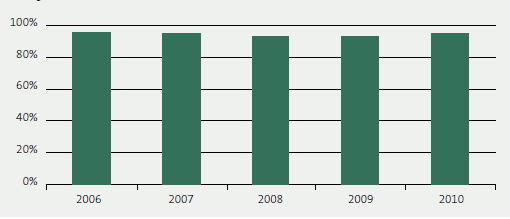 |
| Audit reports on local authorities’ long-term plans are produced within statutory time frames No outstanding longterm plan (LTP) audit opinions at 30 June of the year in which LTPs are to be adopted by local authorities are because of inaction on our part. |
8.9 Long-term plan audits are carried out on a three-yearly basis. In 2009, there were no outstanding audit opinions at 30 June as a result of inaction on our part. |
| Audit reports on local authorities’ long-term plans are produced within statutory time frames All LTP management reports are issued within six weeks of issuing the LTP audit opinion. |
8.10 Long-term plan audits are carried out on a three-yearly basis. In 2009, 85% of management reports were issued within six weeks of issuing the audit opinion. |
| Objective methods are used to allocate audits and set reasonable audit fees An annual independent review of our processes confirms the probity and objectivity of the methods and systems we use to allocate and tender audits, and monitor the reasonableness of audit fees. |
8.11 Results from years 2005/06 to 2009/10 – An annual review was carried out and confirmation provided. |
| Skilled auditors, with a good understanding of public entities, carry out quality audits Client satisfaction survey results show that, overall, 75% of respondents are satisfied with the quality of audit work (including the expertise of staff and the quality of the public entity’s relationship with their audit service provider). |
8.12 Percentage of clients satisfied with the quality of audit work for the five years from 2006 to 2010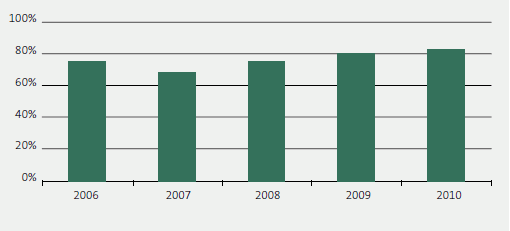 |
| Skilled auditors, with a good understanding of public entities, carry out quality audits Quality assurance reviews for all appointed auditors are completed during a threeyear period. Of the auditors reviewed in any given year, 95% achieve a grade of satisfactory or better. |
8.13 Percentage of auditors achieving a grade of satisfactory or better from quality assurance reviews for the five years from 2006 to 2010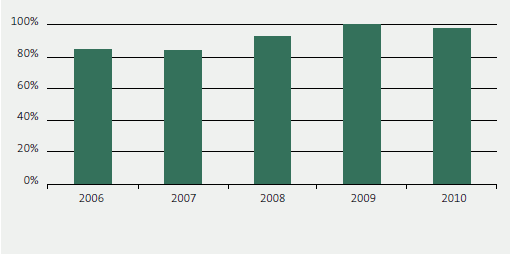 |
| We have sufficient resources to do audits effectively The Officers of Parliament Committee accepts any significant proposals for an appropriation increase in audit fees and expenses. |
8.14 Results: 2009 – A request for an increase in appropriation of $50,000 for audits of smaller entities was not accepted by the Officers of Parliament Committee. 2008 and 2010 – No significant proposal made for an appropriation increase in audit fees and expenses. |
Output class: Supporting accountability to Parliament
Parliamentary services
Through our services to Parliament, we provide advice and assistance to select committees, Ministers, and individual members of Parliament, as well as to central agencies and other public sector representative groups, to assist them in their work to improve the performance and accountability of public entities.
The main ways in which this advice and assistance occurs is through:
- reports and advice to select committees to assist their financial reviews of government departments and Offices of Parliament, State-owned enterprises, and some Crown entities;
- reports and advice to select committees to assist their examination of the Estimates of Appropriations; and
- reports to responsible Ministers on the results of the annual audits.
We also provide advice and assistance through:
- reports to Parliament and other constituencies on matters arising from our annual audits (including at least two reports to Parliament on the results of our audits in central and local government);
- responding to requests and participating in working parties on matters related to financial management and accountability with other stakeholders, including government departments, central agencies, local authorities, professional bodies, sector organisations, and other public entities; and
- working with Auditors-General in other countries to encourage, promote, and advance capability and co-operation in the field of public audit. This includes our role as Secretariat of the Pacific Association of Supreme Audit Institutions, being a member of various committees of the International Organisation of Supreme Audit Institutions, and being executing agent for the Pacific Regional Audit Initiative (funded by the Asian Development Bank, with co-financing from the Japan Special Fund and the Governments of New Zealand and Australia).
The Controller function
The Controller function of the Controller and Auditor-General provides independent assurance to Parliament that expenses and capital expenditure of government departments and Offices of Parliament have been incurred for purposes that are lawful and within the scope, amount, and period of the appropriation or other authority.
The OAG and appointed auditors carry out standard procedures to give effect to the Controller function in keeping with the Auditor-General’s auditing standards and a Memorandum of Understanding with the Treasury. This involves reviewing monthly reports provided by the Treasury, and advising the Treasury of any issues arising and the action to be taken.
Each year, we report to Parliament on the significant issues arising from the operation of the Controller function.
Our focus
In Supporting accountability to Parliament, in 2011/12, we are focusing on:
- Performance information – We are providing advice to parliamentary select committees on how to use performance information from Government departments and Crown entities to assess and enquire into effectiveness and efficiency, particularly in a cost-constrained environment. We are also liaising with Government departments and Crown entities to help them improve their performance information and using it to consider effectiveness and efficiency.
- Sharing sector knowledge – We are focusing on how to better use and present information about sectors within the public sector to Parliament, select committees, and public entities.
The Vote estimate for the Supporting accountability to Parliament output class in 2011/12 is $2.860 million.
Our impacts and outputs for Supporting accountability to Parliament are summarised in Figure 9. Details of our measures and standards, and our previous performance, for this output class are shown in Figure 10.

Figure 9
Summary of impacts and outputs for Supporting accountability to Parliament
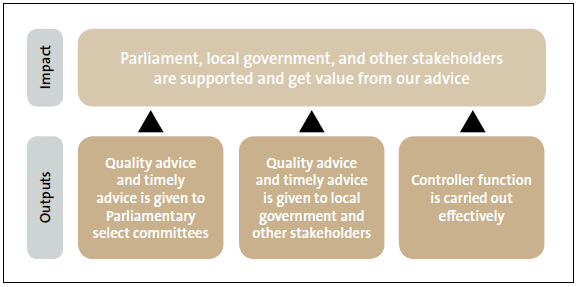
Figure 10
Impact and output measures and standards, and previous performance, for Supporting accountability to Parliament
| Measures and standards | Previous performance |
|---|---|
| Parliament, local government, and other stakeholders are supported and get value from our advice At least 85% of select committee members confirm that our advice assists them in Estimates of Appropriation and financial review examinations. |
10.1 Percentage of select committee members who confirmed that our advice assists them in Estimates of Appropriations and financial review examinations for the four years from 2007 to 2010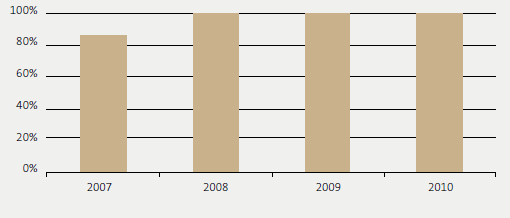 |
| Parliament, local government, and other stakeholders are supported and get value from our advice At least 85% of local government and other stakeholders we survey rate the advice they receive from us as 4 or better on a scale of 1 to 5 for relevance and usefulness. |
10.2 Percentage of local government and other stakeholders who rated our advice as 4 or better on a scale of 1 to 5 for relevance and usefulness for the four years from 2007 to 2010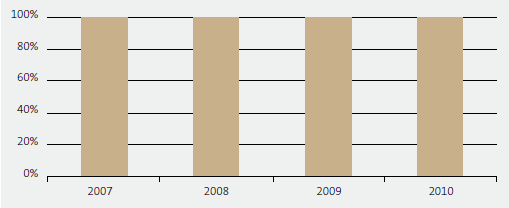 |
| Quality advice and timely advice is given to Parliamentary select committees At least 85% of select committee members we survey rate the advice they receive from us as 4 or better on a scale of 1 to 5 for quality and usefulness. |
10.3 Percentage of select committee members who rated our advice as 4 or better on a scale of 1 to 5 for quality and usefulness for the five years from 2006 to 2010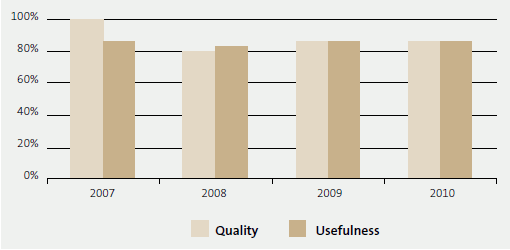 |
| Quality advice and timely advice is given to Parliamentary select committees Reports and advice are given to select committees and Ministers at least two days before an examination, unless otherwise agreed. |
10.4 Percentage of reports and advice given to select committees and Ministers at least two days before an examination, unless otherwise agreed, for the four years from 2007 to 2010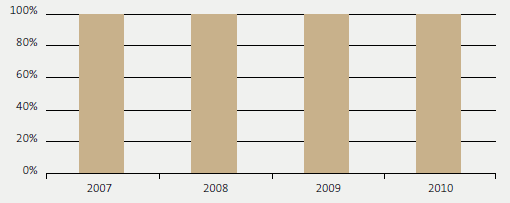 |
| Quality advice and timely advice is given to Parliamentary select committees An internal review of a sample of financial review, Estimates of Appropriations, and Ministerial reports confirms that they meet relevant standards and procedures, including that reports are consistent in their framework and approach and are peer reviewed in draft. |
10.5 Results: 2009 and 2010 – There was no internal review in these years. 2008 – Confirmed internal review of a sample of reports. (The nature, extent, and frequency of the quality assurance review are based on risk. The review is carried out during a three-year period.) |
| Controller function is carried out effectively Internal quality assurance is undertaken to gain assurance that our policies, procedures, and standards for the Controller function have been applied effectively. |
10.6 Results: 2008/09 – An internal review was carried out in May 2009, which confirmed that the central work carried out was consistent with the Memorandum of Understanding and that the monthly processes operated effectively. There was considerable improvement in the appropriation audit approach and documentation to demonstrate compliance with the Auditor-General’s auditing standard AG-2. (The nature, extent, and frequency of the quality assurance review are based on risk. The review is carried out during a three-year period.) |
| Controller function is carried out effectively Monthly statements provided by the Treasury are reviewed for the period September to June inclusive. Advice of issues arising and action to be taken is provided to the Treasury and appointed auditors within five working days of receipt of the statement. |
10.7 Results: 2006-10 – All monthly procedures have been followed and agreed time frames achieved |
Output class: Performance audits and inquiries
The Public Audit Act 2001 provides the Auditor-General discretion to carry out performance audits to look at:
- the extent to which activities are carried out effectively and efficiently;
- compliance with statutory obligations;
- any acts or omissions to determine whether waste has resulted or may result; and/or
- any act or omission showing or appearing to show a lack of probity or financial prudence by a public entity or its members, office holders, or employees.
Each year, we usually publish 19 to 21 reports on performance audits, inquiries, and good practice guides. We also publish reports on the results of annual audits for the central and local government sectors.
The Act also gives the Auditor-General the ability to inquire into a public entity’s use of its resources.
Our inquiry work is largely reactive to issues of public concern. Each year, we usually receive:
- 200 to 300 external requests for inquiries; and
- 50 to 100 enquiries under the Local Authorities (Members’ Interests) Act 1968.
The Auditor-General must also respond to requests for approvals about pecuniary interest questions regulated by the Local Authorities (Members’ Interests) Act.
Our performance audit and inquiry work allows the Auditor-General to consider and provide advice about the above matters in greater depth than is appropriate within the statutory scope of an annual audit.
Our focus
Within our performance audit and inquiry work, we will be focusing on:
- Choosing a cross-cutting theme for 2012/13: We will carry out consultation and work programme development in 2011/12 to choose the theme for our audit effort in 2012/13. Our aim is for this work to make a lasting difference to the New Zealand public sector.
- Performance information: We will continue to prepare and publish better practice examples during 2010–13 and will look to prepare a performance audit report that demonstrates the uses and usefulness of external performance information.
The Vote estimate for the Performance audits and inquiries output class in 2011/12 is $6.587 million.
Our impacts and outputs for Performance audits and inquiries are summarised in Figure 11. Details of our measures and standards, and our previous performance, for this output class are shown in Figure 12.

Figure 11
Summary of impacts and outputs for Performance audits and inquiries
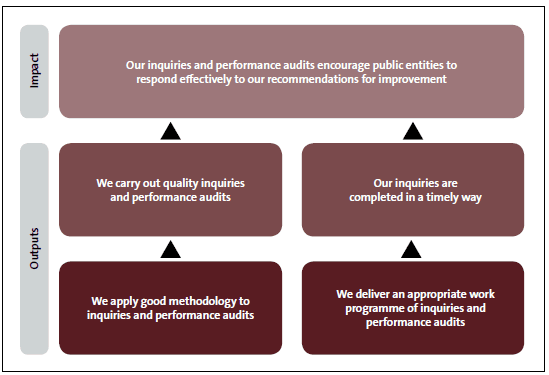
Figure 12
Impact and output measures and standards, and previous performance, for Performance audits and inquiries
| Measures and standards | Previous performance |
|---|---|
| Our inquiries and performance audits encourage public entities to respond effectively to our recommendations for improvement Public entities accept or respond to the recommendations made in our performance audits, as assessed by internal review of performance audit reports published in the previous year. The results are presented to the Officers of Parliament Committee in our annual follow-up report. |
12.1 Results: A selection of our performance audit reports was reviewed each year from 2006 to 2010, and the results were presented to the Officers of Parliament Committee. The reviews concluded that our recommendations had been accepted by the relevant public entities and either had been implemented or were being implemented. |
| Our inquiries and performance audits encourage public entities to respond effectively to our recommendations for improvement Public entities take action in response to concerns identified in inquiry reports, as assessed by follow-up on a sample of sensitive and major inquiries carried out in the previous year. |
12.2 Results: 2010 – We followed up on four of our 13 inquiries within these categories from the previous year that contained recommendations or suggestions for action. There was a high acceptance of our views and comments, which were contributing to significant change. 2009 – We followed up on four of the 11 inquiries within these categories from the previous year that contained recommendations or suggestions for action. In all instances, we were satisfied with the action taken. 2008 – We followed up on the one sensitive inquiry that was carried out in 2006/07 (there were no major inquiries). The entity has taken positive steps to address the comments we made. |
| We carry out quality inquiries and performance audits An independent review of two performance audits each year confirms the quality of the reports in terms of the presentation of administrative and management context, report structure, presentation, and format (including use of graphics and statistics), and the reasonableness of the methodology used and the resulting conclusions and recommendations. |
12.3 Results: 2007 to 2010 – Independent reviews of two performance audits confirmed the quality of reports and provided feedback on areas for us to improve. |
| We carry out quality inquiries and performance audits At least 85% of the stakeholders that we seek feedback from rate our performance audit reports (relevant to their sector or interest) as 4 or better on a scale of 1 to 5 for quality and usefulness. |
12.4 Percentage of select committee, local government, and other stakeholders who are satisfied with the quality and usefulness of our performance audit reports for the four years from 2007 to 2010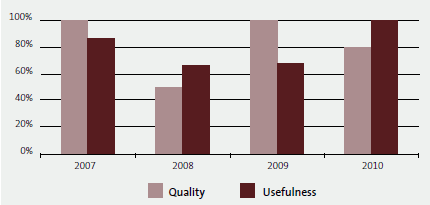 |
| We carry out quality inquiries and performance audits Responses to requests for inquiries and our administering of the Local Authorities (Members’ Interests) Act 1968 requests are in keeping with relevant policies, procedures, and standards, as confirmed by internal quality assurance review. |
12.5 A review was completed in 2010/11 and confirmed that responses to requests were made in keeping with relevant policies, procedures, and standards. No review of our inquiries was undertaken in 2008/09 or 2009/10. A review was completed in 2007/08 and confirmed that responses to requests were made in keeping with relevant policies, procedures, and standards. (The nature, extent, and frequency of the quality assurance review are determined based on risk. The review is carried out during a three-year period.) |
| Our inquiries are completed in a timely way 80% of our findings on inquiries are reported to the relevant parties within:
|
12.6 Percentage of findings on routine inquiries reported to relevant parties within three months for the four years from 2007 to 2010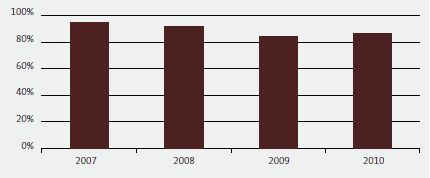 12.7 Percentage of findings on sensitive inquiries reported to the relevant parties within six months for the three years from 2008 to 2010 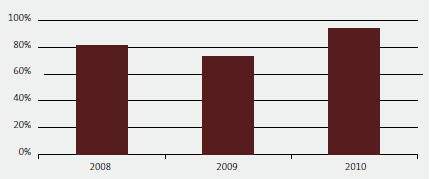 Results for major inquiries: 2008 – No major inquiries were carried out. 2009 – Two major inquiries; both reported within 13 months. 2010 – Five major inquiries; four reported within 12 months. |
| Our inquiries are completed in a timely way For enquiries under the Local Authorities (Members’ Interests) Act 1968, we complete 80% of enquiries within 30 working days. |
12.8 Percentage of enquiries under the Local Authorities (Members’ Interests) Act 1968 completed within 30 working days for the five years from 2006 to 2010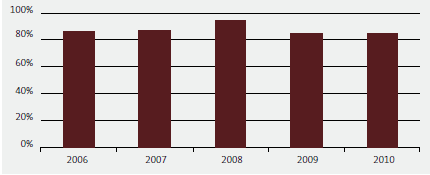 |
| We apply good methodology to inquiries and performance audits Our performance audit methodology reflects good practice for carrying out such audits, as assessed every second year by the Australian National Audit Office. |
12.9 Results: 2008/09 – The Australian National Audit Office reviewed two performance audits and confirmed areas in which the quality of our reports is strong and areas for us to improve. 2006/07 – The Australian National Audit Office reviewed two performance audits and endorsed the quality of the reports. |
| We apply good methodology to inquiries and performance audits Internal quality assurance reviews on selected performance audit reports confirm that reports are prepared in keeping with the performance audit methodology. |
12.10 There was no internal review in 2008/09 or 2009/10. Internal review in 2007/08 confirmed that appropriate systems and controls are in place and that reports are prepared in keeping with the performance audit methodology. (The nature, extent, and frequency of the quality assurance review are based on risk. The review is carried out during a three-year period.) |
| We deliver an appropriate work programme of inquiries and performance audits Select committees and other stakeholders are satisfied with the proposed work programme of performance audits (as indicated by feedback on our draft annual work programme). |
12.11 Results 2006-10: Feedback received from select committees and other stakeholders mainly supported our proposals and approach. |
